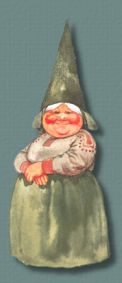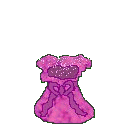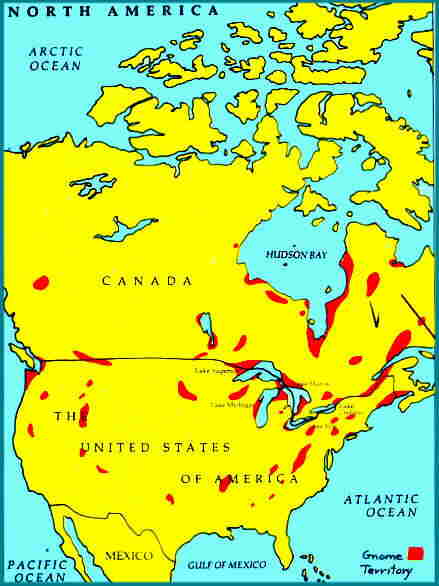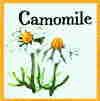The
woodland, or forest, gnome is probably the most common. But this is
difficult to verify, as he is not fond of showing himself to man and has
many escape routes. His physical appearance resembles that of the
ordinary gnome.
The
dune gnome is a fraction larger than the woodland gnome. He, too, avoids
contact with man. His clothing sometimes is remarkably drab.
The female
of this gnome type does not wear gray clothes; hers are khaki-colored.
The
garden gnome belongs to the general type. He lives in old gardens, even
those hemmed in between the new houses of modern "model"
cities. His nature is on the somber side, and he rather enjoys telling
melancholy tales. If he begins to feel too closed in, he simply goes to
the woods. But, as he is quite learned, he sometimes feels out of place
there.
The
farm gnome resembles the house gnome but is of a more constant nature
and is conservative in all matters.
The
house gnome is a special sort. He resembles an ordinary gnome but he has
the most knowledge of mankind. Owing to the fact that he often inhabits
historic old houses, he has seen both rich and poor, and heard a great
deal. He speaks and understands man’s language; gnome kings are chosen
from his family. These gnomes (Farm and House) are good-natured, always
ready for a lark or to tease; they are never malevolent, with a few
exceptions, of course. If a gnome is really wicked—which happens only
once in a thousand –it is due to bad genes that result from
crossbreeding in faraway places. 
The
Siberian gnome has been the most affected by crossbreeding. He is
centimeters larger than the European type and associates freely with
trolls. In certain regions there is not a single gnome to be trusted.
The Siberian gnome takes revenge for even the slightest offense by
killing cattle, causing bad harvests, droughts, abnormally cold weather,
and so forth. The less said about him, the better.
Male
Gnomes frown due to posing in harsh daylight. At 275 years old he is in
the prime of life...actual height (without cap) 15cm. The adult male
gnome weighs 300 grams Tool kit attached to belt. Feet slightly turned
inward to insure great speed (over grass, etc...) wearing deer fur
boots.
The
adult female gnome weighs 250 - 275 grams. Female Gnomes tend to wear
camouflage colors (gray or Khaki). Until she is married she wears a
green cap, with her braids sticking out. After marriage, her hair
disappears under a scarf and darker cap. When 350 years or older she
begins to show a light beard. She usually only stays at home and
doesn’t wander about.


Here
is where you will find Gnomes in Europe and North America



Gnomes
are known in many countries and each has its own name for these little
people. Here are some...
Irish.....................................................................Gnome
English................................................................
Gnome
Flemish....................................................
Kleinmanneken
Dutch
...............................................................Kabouter
German
................................................Heinzelmannchen
Norwegian..............................................
Tomte or Nisse
Swedish
..........................................Tomtenisse or Nisse
Danish
...................................................................Nisse
Polish...................................................................
Gnom
Finnish.................................................................
Tonttu
Russian
...........................................Domovoi Djedoesjka
Serbo
....................................................................Kepec
Croatian................................................................Patuljak
Bulgarian..............................................................
Djudje
Czechoslovakian..................................................
Skritek
Hungarian.............................................................
Mano

 Here
are a few Gnome natural remedies.
Here
are a few Gnome natural remedies.
- Prevention
of High Blood Pressure
 ...........
Shepherd’s Purse (2 grams to 50 cms into boiling tea)
...........
Shepherd’s Purse (2 grams to 50 cms into boiling tea)
Protection
against Flu and Colds................. Elder Blossoms (brew tea)
Elder Blossoms (brew tea)
- Infections
of bronchial passages
 ...............Selfheal
Prunella
vulgaris (gargle)
...............Selfheal
Prunella
vulgaris (gargle)
-
- Curing
Insomnia
 ..................................Camomile
or Dill seed (tea)
..................................Camomile
or Dill seed (tea)
Prevent
flatulence .............. Fennel
Seed (tea)
Fennel
Seed (tea)
Hardening
of the Arteries.....Daily leaf of  Centaury Plant
Centaury Plant
Prevent
or Cure Constipation ....  Dandelion Leaf (tea)
Dandelion Leaf (tea)
Depression
and Listlessness .... St.
John’s - Wort (tea)
St.
John’s - Wort (tea)
Prevent
Kidney Stones .......  Birch
Leaf (tea)
Birch
Leaf (tea)